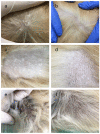Isotretinoin Treatment for Autosomal Recessive Congenital Ichthyosis in a Golden Retriever
- PMID: 35324825
- PMCID: PMC8953346
- DOI: 10.3390/vetsci9030097
Isotretinoin Treatment for Autosomal Recessive Congenital Ichthyosis in a Golden Retriever
Abstract
Ichthyoses are hereditary cornification disorders that manifest with abnormal differentiation and desquamation of keratinocytes in a form of generalized dry and scaly skin. In golden retriever dogs, autosomal recessive congenital ichthyosis (ARCI) has been associated with mutations in the PNPLA 1 gene. In human medicine, isotretinoin is frequently used to treat ARCIs. The aim of this study was to investigate the clinical and histological effects of isotretinoin on ARCI in a golden retriever dog with confirmed mutation in the PNPLA 1 gene. Clinical examination, blood analysis and histopathological examinations were conducted before and after 90 days of isotretinoin therapy. The clinical and histopathological findings indicate that treatment with oral isotretinoin was effective in improving ichthyosis without any side-effects.
Keywords: PNPLA 1; autosomal recessive congenital ichthyosis; golden retriever; ichthyosis; isotretinoin.
Conflict of interest statement
The authors declare no conflict of interest.
Figures


Similar articles
-
PNPLA1 mutations cause autosomal recessive congenital ichthyosis in golden retriever dogs and humans.Nat Genet. 2012 Jan 15;44(2):140-7. doi: 10.1038/ng.1056. Nat Genet. 2012. PMID: 22246504
-
Autosomal recessive congenital ichthyosis due to PNPLA1 mutation in a golden retriever-poodle cross-bred dog and the effect of topical therapy.Vet Dermatol. 2016 Aug;27(4):306-e75. doi: 10.1111/vde.12323. Epub 2016 May 30. Vet Dermatol. 2016. PMID: 27237723
-
[Spontaneous models of human diseases in dogs: ichthyoses as an example].Bull Acad Natl Med. 2013 Jun;197(6):1225-30. Bull Acad Natl Med. 2013. PMID: 25803941 French.
-
Update on autosomal recessive congenital ichthyosis: mRNA analysis using hair samples is a powerful tool for genetic diagnosis.J Dermatol Sci. 2015 Jul;79(1):4-9. doi: 10.1016/j.jdermsci.2015.04.009. Epub 2015 Apr 30. J Dermatol Sci. 2015. PMID: 25982146 Review.
-
Nonsyndromic types of ichthyoses - an update.J Dtsch Dermatol Ges. 2014 Feb;12(2):109-21. doi: 10.1111/ddg.12229. Epub 2013 Oct 11. J Dtsch Dermatol Ges. 2014. PMID: 24119255 Review.
References
-
- Oji V., Tadini G., Akiyama M., Bardon C.B., Bodemer C., Bourrat E., Coudiere P., DiGiovanna J.J., Elias P., Fischer J., et al. Revised nomenclature and classification of inherited ichthyoses: Results of the First Ichthyosis Consensus Conference in Sorèze 2009. J. Am. Acad. Dermatol. 2010;63:607–641. doi: 10.1016/j.jaad.2009.11.020. - DOI - PubMed
Publication types
LinkOut - more resources
Full Text Sources

